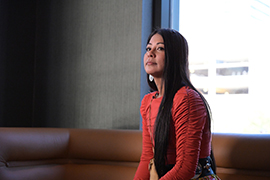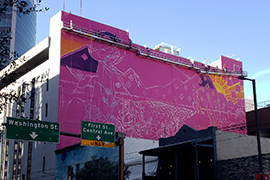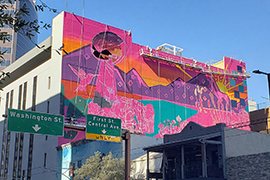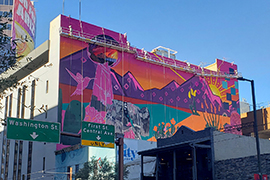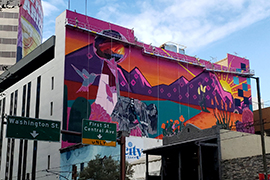- Slug: BC-CNS-Super Artistic,1150.
- 6 photos, time-lapse gif available (thumbnails, captions below)
By Jacinda Palomo
Cronkite News
PHOENIX — Super Bowl 57 has come and gone, but its impact on the local arts community remains in eye-catching bold hues on Phoenix buildings and in the form of a larger national profile it has given several Arizona artists.
Steve Wilcox, communications director for the Arizona Commission on the Arts, said he believes the national sporting event brought more collaboration with Arizona artists and a recognition of local talent.
“Just based on my own observations, I feel like the city really made a strong effort to engage artists,” Wilcox said. “I was very happy to see many opportunities for artists to have their work seen and to have their work featured around the Super Bowl.”
Lucinda “La Morena” Hinojos, Randy L. Barton and Jesse Yazzie are a few of the local artists who left their creative mark.
Dazzling graphics
Randy L. Barton — aka Randy Boogie — is a jack of all trades. This artist, designer, dancer, DJ and music producer incorporates all his experiences into the art he creates, along with his Navajo culture.
Production Club, a Los Angeles creative agency, hired Barton to create dazzling motion graphics that played on the big screens scattered throughout State Farm Stadium when the Philadelphia Eagles and Kansas City Chiefs ran onto the field. He also created digital designs for the LED screens in between seating decks, the end zone and scoreboard, heavily incorporating a Navajo rug design into his creations.
“I don’t think, like, ever that Navajo rug designs have had animation before,” Barton said. “So they’re coming alive, you know, and it’s an authentic piece that I created, and it has an explosive movement.”
Barton, who grew up in Winslow, earned a bachelor’s degree in graphic design from the Collins College School of Design in Tempe. His work has been featured in museums from LA’s Autry Museum of the American West to the Navajo Nation Museum in Window Rock to the Sam Noble Museum in Norman, Oklahoma.
After signing a nondisclosure agreement and being given color and style guidelines, Barton was able to create what he wanted: an explosion of art.
“Where the sky meets the Earth, it explodes, right? With this pattern, I made that,” Barton said, describing a diamond pattern that he says is representative of a mountain or cloud.
Barton’s art explores his background in the hip-hop subculture, traditional Navajo teachings from his youth and memories of his grandmother.
In addition to his Super Bowl animation, Barton worked alongside Hinojos in the early stages of her mural — the largest ever commissioned by the NFL — located on the Monarch Theatre in downtown Phoenix. Its magenta sky combined with the orange glow from the sun is meant to capture the relationship of Indigenous’s people’s place between land and sky, while the turquoise-and-magenta embroidered rug symbolizes home, place and the connections that weave us together, according to a statement by the NFL. Barton says the mural experience was like no other.
“When it comes to creating art, I love it, because no one will ever know these other bizarre ideas that we had, except for whoever was in that room,” Barton said. “We probably went through hundreds of ‘what ifs,’ and to decide what people see, it tends to go beyond, to the point where it’s, like, not even about the Super Bowl anymore.”
‘It’s a blessing’
Phoenix native and Navajo artist Jesse Yazzie has created several downtown murals and was also among the small group of local artists who worked on Hinojos’ design — a project he called inspiring.
“If you look at the mural, I painted the face, I painted the hands, I painted the shoes, I painted the basket, you know, along with the other artists, and it just shows that my work is able to be on this level,” Yazzie said. “I’m capable of doing something so much bigger than I thought. It means so much to me, to my family, to my friends. There’s a lot of meanings I could probably give you, but to make it sweet and simple, it’s a blessing.”
Yazzie said he overcame a lot of obstacles and has mined those challenges in his work. Released from prison two years ago, he served time on aggravated DUI and theft charges.
“I’m from a real crazy household. Both of my parents had problems with domestic violence situations, and there was a lot of drugs and alcohol involved,” said Yazzie, who added he gravitated toward art with dark themes and struggled to jump-start his art career.
“I’m from the streets. I never learned how to work a computer. I never learned how to send an email. I didn’t know how to accept money or how to do, like, a website or how to take pictures of my stuff,” Yazzie said.
Regardless, he persisted and slowly learned how to build his platform. Art, he said, is his therapy.
“A huge inspiration of my artwork comes from my experiences. So like my focus, my motivation, my determination, all of that stemmed from serving a lot of time in prison,” Yazzie said. “Just thinking about this dream of being an artist so I have an expectation for myself, that really drives me to not stop until I’m successful.”
Yazzie said the Super Bowl seemed to bring more attention to the local arts community.
“I definitely think there was more push for artwork to be involved,” Yazzie said. “I think that they’re trying to go bigger, and I think that incorporating Native American and Chicano artists together to do something like this is so powerful.”
Largest ever Super Bowl mural
Glendale native Hinojos is the very first Chicana/Native American woman to partner with the NFL, taking on the biggest art project of creating a downtown mural for the Super Bowl and doing it in her own distinct way.
Hinojos designed artwork featured on Super Bowl tickets, advertisements, a Wilson football, and the eye-catching 9,500-square-foot mural located on Second and Washington streets in downtown Phoenix.
The mural is the largest Super Bowl mural ever created, according to an NFL statement. It symbolizes the relationship between the Indigenous community and the land and sky, their histories and traditions, and the importance of collaboration, which is something that Hinojos made a huge part of the process.
“I create art to hopefully provide an element of healing, unity and real human connection, so with this Super Bowl piece, I hope people from all over the world can have a dialogue about what this painting means to them… and that’s what’s beautiful to me,” Hinojos said in an interview with NFL.
In addition to Barton and Yazzie, Hinojos’ team included Eunique Yazzie (not related to Jesse Yazzie) Carrie “CC” Curley, Anitra “Yukue” Molina, Stephanie Guillermina Castro and Giovanni “Just” Dixon. Each of these artists worked together to bring the vision to life, collaborating together to create an image that would reflect and resonate with the Indigenous community.
For more stories from Cronkite News, visit cronkitenews.azpbs.org.
^__=
Lucinda Hinojos, a local Chicana, Native American artist known as “La Morena,” designed and painted with a team a 9,500-square-foot mural for Super Bowl 57, in downtown Phoenix. Photo taken on Feb. 7, 2023. (Photo by Izabella Hernandez/Cronkite News)
First in the series. Collaborating with several other Indigenous artists, Lucinda “La Morena” Hinojos created a 9,500-square-foot mural that colorfully conquers the skyline in downtown Phoenix. (Photos by Robert Crompton/Cronkite News)
Second in the series. Collaborating with several other Indigenous artists, Lucinda “La Morena” Hinojos created a 9,500-square-foot mural that colorfully conquers the skyline in downtown Phoenix. (Photos by Robert Crompton/Cronkite News)
Third in the series. Collaborating with several other Indigenous artists, Lucinda “La Morena” Hinojos created a 9,500-square-foot mural that colorfully conquers the skyline in downtown Phoenix. (Photos by Robert Crompton/Cronkite News)
Fourth in the series. Collaborating with several other Indigenous artists, Lucinda “La Morena” Hinojos created a 9,500-square-foot mural that colorfully conquers the skyline in downtown Phoenix. (Photos by Robert Crompton/Cronkite News)
Last in the series. Collaborating with several other Indigenous artists, Lucinda “La Morena” Hinojos created a 9,500-square-foot mural that colorfully conquers the skyline in downtown Phoenix. (Photos by Robert Crompton/Cronkite News)
